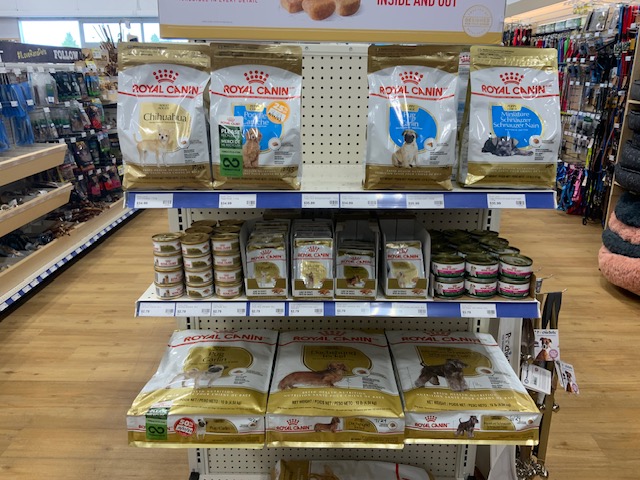20 Oct How to Feed Your Puppy

6-12 Weeks
Growing pups should be fed puppy food, a diet specially formulated to meet the nutritional needs for normal development. Four feedings a day are usually adequate to meet nutritional demands.
3–6 Months
Sometime during this period, decrease feedings from four to three a day. A pup should be losing her potbelly and pudginess by 12 weeks. If she is still roly-poly at this age, continue to feed puppy-size portions until body type matures.
6-12 Months
Begin feeding twice daily. Spaying or neutering lowers energy requirements slightly; after the procedure, switch from nutrient-rich puppy food to adult maintenance food. Small breeds can make the switch at 7 to 9 months; bigger breeds at 12, 13, even 14 months. Err on the side of caution: Better to be on puppy food a little too long than not long enough.
After Age 1
Most owners feed adult dogs two half-portions a day.
There’s a saying in canine feeding: Watch the dog, not the dish. Body condition, not the amount eaten or left in the bowl, should determine portion sizes. Portion sizes depend on individual metabolism and body type, and nutritional requirements vary from dog to dog. If your puppy occasionally skips a meal or picks at food, don’t worry. It could mean she is ready to eliminate a feeding or that you have given her too much, in which case simply reduce the quantity served.
Also, if you are doing treat-based training with your pup, adjust the amount you feed at mealtime accordingly. Whenever training with treats, keep the treat as small as possible.
How often should I feed my puppy?
Like human babies, puppies start out needing many small meals a day, of a food formulated for their special nutritional requirements. Most, but not all, dogs finish meals quickly. To discourage picky habits, feed at regular times in regular amounts and don’t leave food down for more than 10 to 20 minutes.
Is it worth it to buy the more expensive stuff?
Premium food has higher nutritional density, so you can feed your dog less to achieve the same results. Also, premium foods have stable ingredient profiles; the composition of bargain brands can vary from batch to batch.
The major dog-food companies invest heavily in product development and research, constantly upgrading formulas to keep up with their competitors. This means that feeding premium food puts you on the cutting edge of canine nutrition.
Dry Food, Wet Food, or Both?
Many pet-food companies have worked with canine-nutrition scientists to develop special formulas for both large- and small-breed puppies.
Canned Food
The most expensive to feed, and dogs often find it most palatable. Be careful of “all-meat” claims, though. Your dog should have a complete, balanced diet to fulfill nutritional requirements. Meat alone may not do it.
Semi-moist Food
Available in one-serving packets. It is usually made to look like hamburger.
Kibble
Is the most economical, and the major makers offer a complete and balanced diet for dogs of all sizes and ages. Dry food can be fed exactly as it comes from the bag.
Some dog owners say there is an oral-hygiene advantage in hard kibble because the friction produced helps to keep the gums and teeth healthy. Kibble can be moistened, either with water or canned food. Although unnecessary, that addition may make food tastier.
Food For Big Puppies & Little Puppies
There are differences between the nutritional needs of small-breed and large-breed dogs, and that is especially true for puppies. Adult dogs who weigh less than 20 pounds are considered small-breed dogs. These puppies grow quickly and may reach adulthood by 9 months. Large-breed puppies (20 pounds and up), grow more slowly—it takes anywhere from 15 to 24 months to reach full size and maturity.
Chart Your Puppy’s Weight and Growth
There are growth-and-weight charts available in print and online. Weigh the puppy weekly and record his progress, comparing him to breed-appropriate weight charts. Adjust his food intake to achieve an average rate of growth.
Weighing a dog, even a squirming puppy, is easy. Just weigh yourself, then weigh yourself holding the puppy. Subtract the difference—that’s the puppy’s weight. Voila!
Don’t worry about an ounce or two either way; no two dogs, even within breeds, are built exactly alike.
A young dog carrying too much weight has an increased risk of orthopedic problems, due to stress on immature joints. Obesity can also lead to diabetes, diseases of the heart and other organs, and general lethargy.
Puppy Feeding Tidbits
- Feeding your pup the moment you get home may encourage separation anxiety. Play or grooming is a more positive way to say hello.
- When medically necessary, you can purchase canned or dry prescription diets from veterinarians to feed dogs with kidney disease, heart disease, diabetes, and other serious conditions. These foods should never be fed without a prescription.
- Some vitamin or mineral supplements, when utilized incorrectly (such as extra calcium given to a large-breed dog on a good diet) will do more harm than good.
- Small portions of carrot or apple chunks are healthful low-calorie snacks most dogs love.
- Fresh water should be available at all times. During the summer months, consider setting up multiple indoor/outdoor water stations. To avoid a buildup of bacteria, wash the water bowl daily
How to Switch from Puppy Food to Adult Food
When switching from puppy food to adult food, you should make the switch gradually over a period of a few days. A sudden change in your dog’s diet may cause stomach upset. Talk to your veterinarian about the best type of food for your dog.
Final Thoughts
Your entire household must be committed to your dog’s feeding regimen. If there’s a soft touch for a handout in your family, your dog will find it and exploit it, thus undoing the good you are trying to do. Keeping a dog trim takes a conscious effort from everyone on your team. And remember: There is room for only one alpha dog in your house, and that’s you. Allowing a dog to beg at the table undermines your status as pack leader, resulting in training and behavior problems.
And last but not least; Make sure everyone gets with the program!

